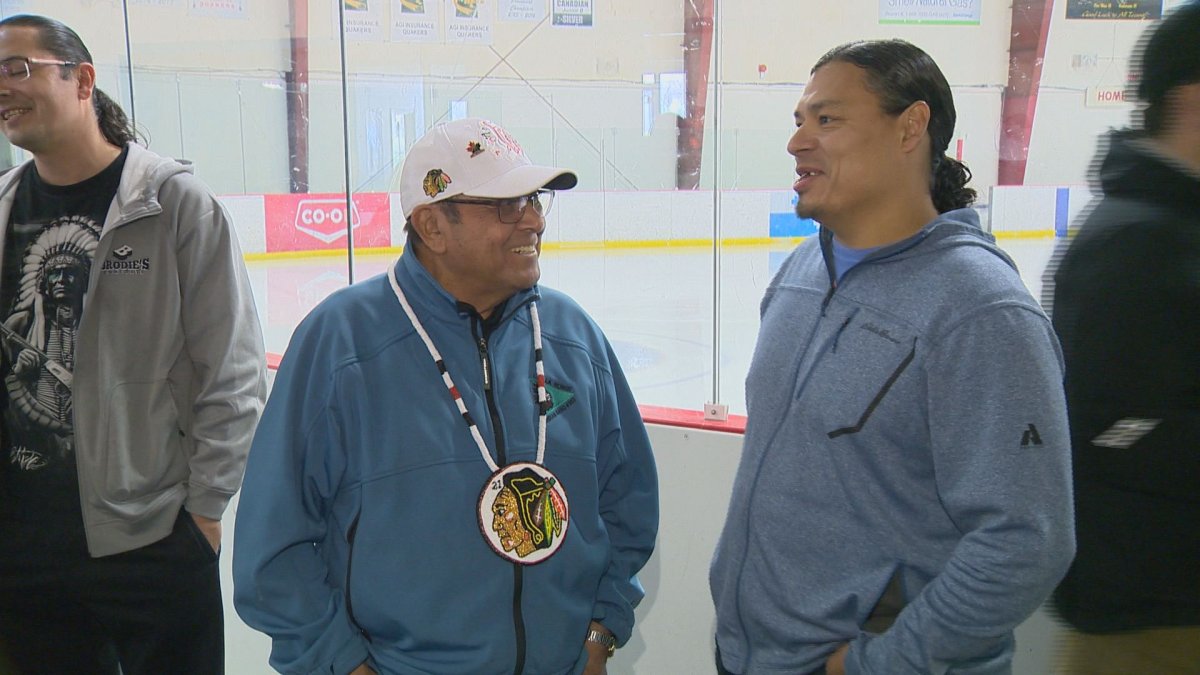Of the thousands of players who have made it to the National Hockey League (NHL), just 54 are aboriginal.

Fred Sasakamoose, the first aboriginal to ever play in the NHL in 1954, and Ted Nolan, a trailblazing coach and player, are trying to make those dreams more accessible to the next generation.
READ MORE: Teaching aboriginal culture through hockey
“It’s our obligation to continue to inspire the next generation to play,” said Nolan, who coached the Buffalo Sabres between 1995-97 and again from 2013-15, and the New York Islanders from 2006-08.
“Because we have a lot more talented kids out there who certainly could play at that level.”
“I believe sports takes you a long way, it took me a long ways. I’m not saying that I was an angel, but it created a man, a believer, that Indian and Métis people deserve a better life” added Sasakamoose, who struggled with alcoholism earlier in his life.
Sasakamoose witnessed first hand the perils that face people in his community.
“Suicide, drugs, gangs, HIV, diseases that invaded our Indian people. We have to do something. Of course education comes first there’s no doubt about it, but also the creation of sports.”
WATCH BELOW: Fred Sasakamoose overcame monumental obstacles to succeed in the world of hockey

Both Nolan and Sasakamoose have helped develop indigenous hockey tournaments. Sasakamoose hosts his annual “Chief Thunderstick” All Reserve/Métis Senior Contact Hockey tournament in Saskatoon.
Nolan says that some of his fondest memories are playing in a tournament in Ontario that was tailored specifically to First Nations youth.
“The best part about it was you weren’t trying to fit in, no racism, no name calling, we’re all on the same level playing field. A lot of us didn’t have the proper sticks and we shared them from team to team. We even shared helmets from team to team, it was a great place to come to celebrate and play a sport we all loved,” Nolan reflected.
“I just think there’s so much untapped potential out there, but the awareness is not there.”
READ MORE: Fred Sasakamoose reflects on journey to the National Hockey League
Currently, there are only eight indigenous players in the National Hockey League, the most ever. But how easy is it for aboriginal youth to reach that level in this day and age?
“I think it’s harder now,” Nolan siad.
“To tell you the truth, before, a kid like myself could come from the reserve and not go through all these triple-A programs. But now, these kids starting off so young, they have the hockey schools that are high level hockey schools, elite hockey schools, they’re conditioning themselves at a very young age.
“So when you come without that equipment, when you’re 15, 16 years old, it’s very hard to compete.”
WATCH BELOW: Obstacles aboriginal kids face as they try to realize their hockey dreams

Louis Gardiner, one of the committee members of the Fred Sasakamoose Hockey Tournament, feels more has to be done from a governmental level.
“I think we really have to push aboriginal sports, and aboriginal hockey in Canada and come up with a strong aboriginal sports strategy,” Gardiner stated.
Sheldon Wuttunee, another committee member, echoed similar sentiments.
“I mean you get funding for education, you get funding for operation maintenance and those types of things, but dedicated funding to really build our athletes to a level of excellence, to reach those elite arenas is something, that needs to be paid a little more attention too,” Wuttunee said.
When Sasakamoose played, he was a target of racism. Hockey helped him gain a sense of self-confidence.
“I could walk with the white man, I could be able to lift my head up, just as high as he can, at the same level,” Sasakamoose said.
Now at the age of 83 , the residential school survivor just wants to see First Nations youth have those same opportunities.
“I think it would change the world, I think it would change our lives. I feel it and I see it today,” Sasakamoose stated.


Comments